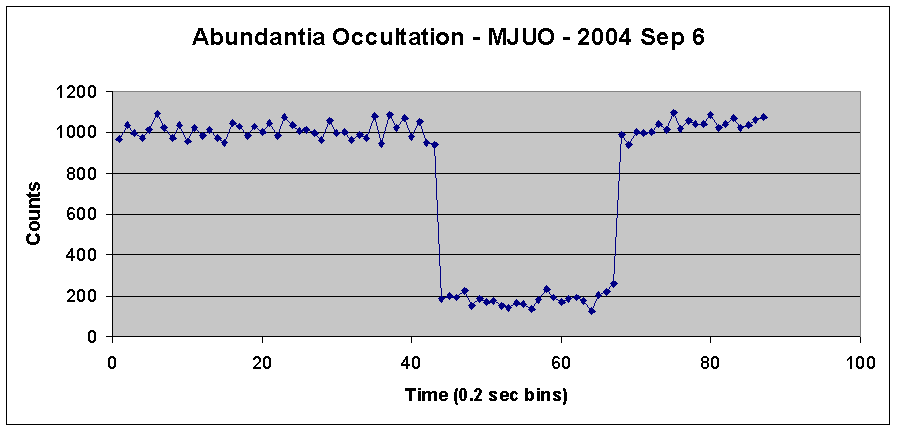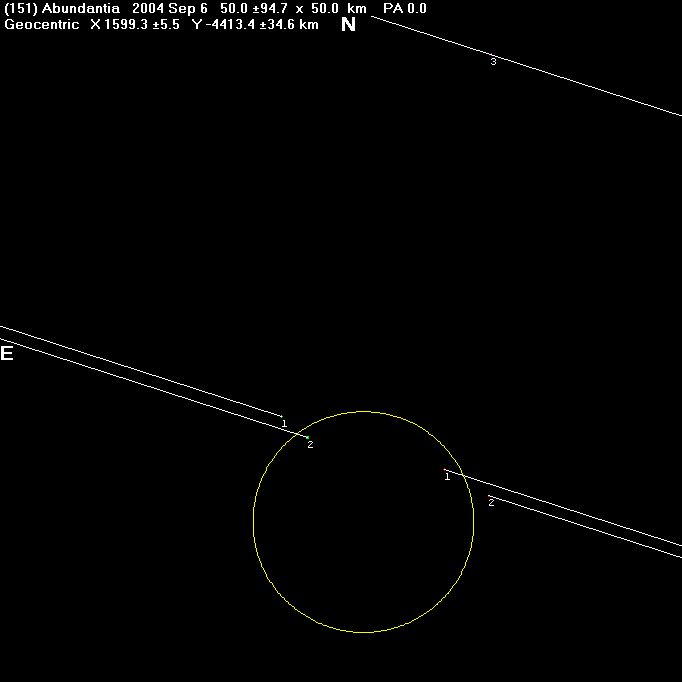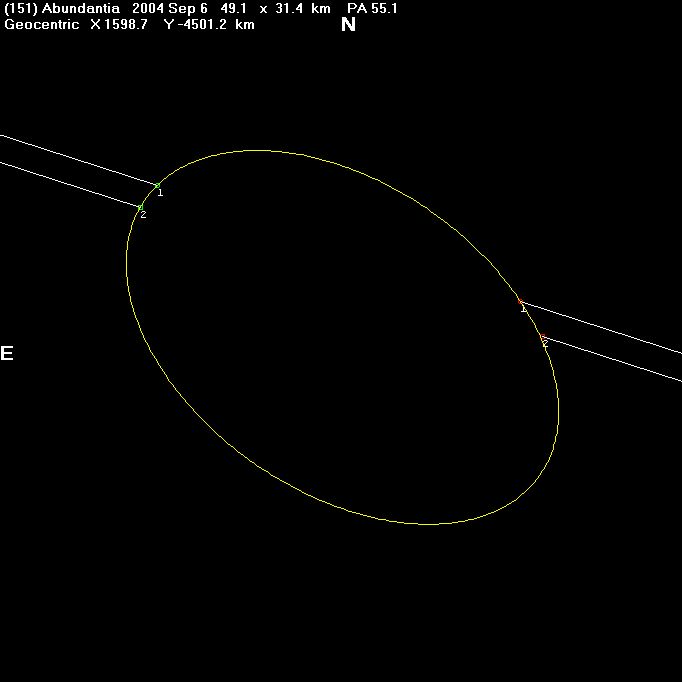Preamble:
The updated path for this event touched the southern tip of the North Island of New Zealand, and then crossed the South Island with Mt John and Darfield expected to be within the track.
A video chord was obtained by Brian Loader at Darfield and a photoelectric chord by Alan Gilmore at Mt John. Bill Allen using the CCD drift-scan technique recorded a miss.
Observers: 1 A. Gilmore, Mt John, NZ (PHOTOELECTRIC) 2 B. Loader, Darfield, NZ (VIDEO) 3(M) B. Allen, Blenheim, NZ (CCD) M = Miss
Discussion:
This is a reasonably good result, in that we have two chords with timing accuracies significantly better than can be obtained visually. However the two chords are close together which makes it impossible to derive a definitive fit; variation of the asteroid parameters over a wide range still gives various matches to the data. It is a pity that at least one more chord was not obtained on the eastern side of the track. (The observations indicate that the track of this rank "79" event shifted somewhat to the east).
Mt John Photoelectric Data:

The initial match to the two chords was poor. Notwithstanding the fact that the Mt John data was stated to be only accurate to ±0.5 sec in absolute time, the Mt John chord still appeared to be offset from the Darfield chord, and no amount of matching could reconcile these. (The circle in the plot below is at the expected 45 km diameter of Abundantia):

There seemed to be a possibility (see report below) that the Mt John data might be time-shifted by 1 second. By shifting the Mt John occultation by -1.0 sec relative to the times reported, a much more pleasing result for the two chords could be obtained:

(Plots generated using WinOCCULT - Disappearances on the right; Reappearances on the left)
NOTE: The match above is by no means unique as there is insufficient data to produce a definitive result. Several other fits with substantially different major and minor axes and orientations also match these two chords.
Summary:
A good high time-resolution result which would have been significantly augmented by one additional observation from the other side of the track.
Observational Data:
Observer's Name : Alan Gilmore
Aperture (cm) : 60 cm
Focal length (cm) : 960 cm
Type (e.g. SCT; Newtonian) : Cassegrain
Magnification : n/a
Observing site name : Mt John Observatory
Longitude (DD MM SS ; East +ve) : +170 27.9
Latitude (DD MM SS ; South -ve) : -43 59.2
Height above Sealevel (metres) : 1000
Geodetic Datum (e.g.WGS84,NZ1949): (? from Astron. Almanac)
Height Datum (if known) :
Sky Transparency (Delete two) : Good
Star Image Stability (Delete two): Good
Other Conditions: weak moonlight from 49% moon
Time Source (e.g. WWVH, GPS) : Computer clock started by keypress from GPS display.
Recording method (e.g. tape) : Photometer to computer memory
Could you see the Asteroid? : Yes
Approx. Limiting Magnitude : 14.5
| Estimated
|Universal Time | Reaction | Remarks
h m s | Time (sec) |
Started Observing : 15:59:30
Disappearance At : 16:03:31.6
Reappearance At : 16:03:36.4
Stopped Observing :~16:04:30
Accuracy, ±0.5 s for absolute time Interval accurate to ± 0.2 s. See appended log.
COMMENTS: Interval well timed. Absolute time probably accurate to
±0.5 sec. I restarted the computer's clock on our GPS readout. There were no
time signals to get any sort of check calibration.
ADDITIONAL COMMENTS - 10 SEP 2004:
Given the haste with which I set things up for the occultation -- I wasn't
otherwise observing that night -- I guess it's likely that I mis-read a time
somewhere, or our rather primitive GPS readout was misbehaving. Certainly the
chords look a lot better if the MJ time is corrected by a second.
Observer's Name : Brian Loader
Aperture (cm) : 25.4
Focal length (cm) : 250
Type (e.g. SCT; Newtonian) : SCT
Magnification : n/a
Observing site name : Darfield
Longitude (DD MM SS ; East +ve) : +172° 06' 24.4" E
Latitude (DD MM SS ; South -ve) : -43° 28' 52.9" S
Height above Sealevel (metres) : 210
Geodetic Datum (e.g.WGS84,NZ1949): WGS84
Height Datum (if known) : MSL
Sky Transparency (Delete two) : Good
Star Image Stability (Delete two): Fair
Time Source (e.g. WWVH, GPS) : GPS/KIWI
Recording method (e.g. tape) : VIDEO
Could you see the Asteroid? : no
Approx. Limiting Magnitude : 11.5 on video
| Estimated |
Universal Time | Reaction | Accuracy, Remarks
h m s | Time (sec) |
Started Observing : 15:56
Disappearance At : 16:03:12.50 +/-.05
Reappearance At : 16:03:17.83 +/-.05
Stopped Observing : 16:56
Was your reaction time (also known as Personal Equation) subtracted from
any of the above timings? : eliminated
ADDITIONAL COMMENTS: The 10.6 magnitude, and the image being only moderate stability,
means that frame counting was marginal, especially for the disappearance. However I think
the times above are reliable.
I also timed with a stop watch from the monitor screen. By this method I would have
estimated an occultation for 5.2 seconds, ie about 0.1 second less.
Alan Gilmore timed an event for 4.8 seconds, the above event lasts 5.33 seconds. If anything
Mt John was slightly nearer the expected path than Darfield. The orginal path was to the
north-west of Mt John and Darfield, so there was a shift to the south-east compared to this.
From our two results it looks as if the centre line may have moved to to the other side of us.
Observer's Name : Bill Allen
I attempted a CCD drift scan on this object. Before the event I could easily see the MP to
the west of the star. It then merged. The weather was perfect 5.4 degrees !
From the chart I determined the time of the event in Blenheim to be 16 02 46.9. The scan
started at 16 02 09 and ended at 16 03 15. No occultation occured. The image profile was
checked using MaxIm CCD. If an event ocurred it would have been easily seen both in the image
and on the line profile.
I could not use a stop watch to record the start and end of the exposure because the WWV time
signal was poor. It was however good enough to confirm that the computer clock was accurate at
the end of the observation. Earlier in the evening I had synchrosed the computer clock with the
USNO time synchroniser and checked it with WWV. It was good to the second.
This is the first time I have used this method to record an occultation and it will be a very
powerful method, however I will have to refine the timing. I had stopwatches to record the start
and end of the exposure, but what I really need is an accurate clock that can be synchronised to
WWV.
Abundantia has not previously been observed at occultation.
[Top of Page][Return to Home Page]